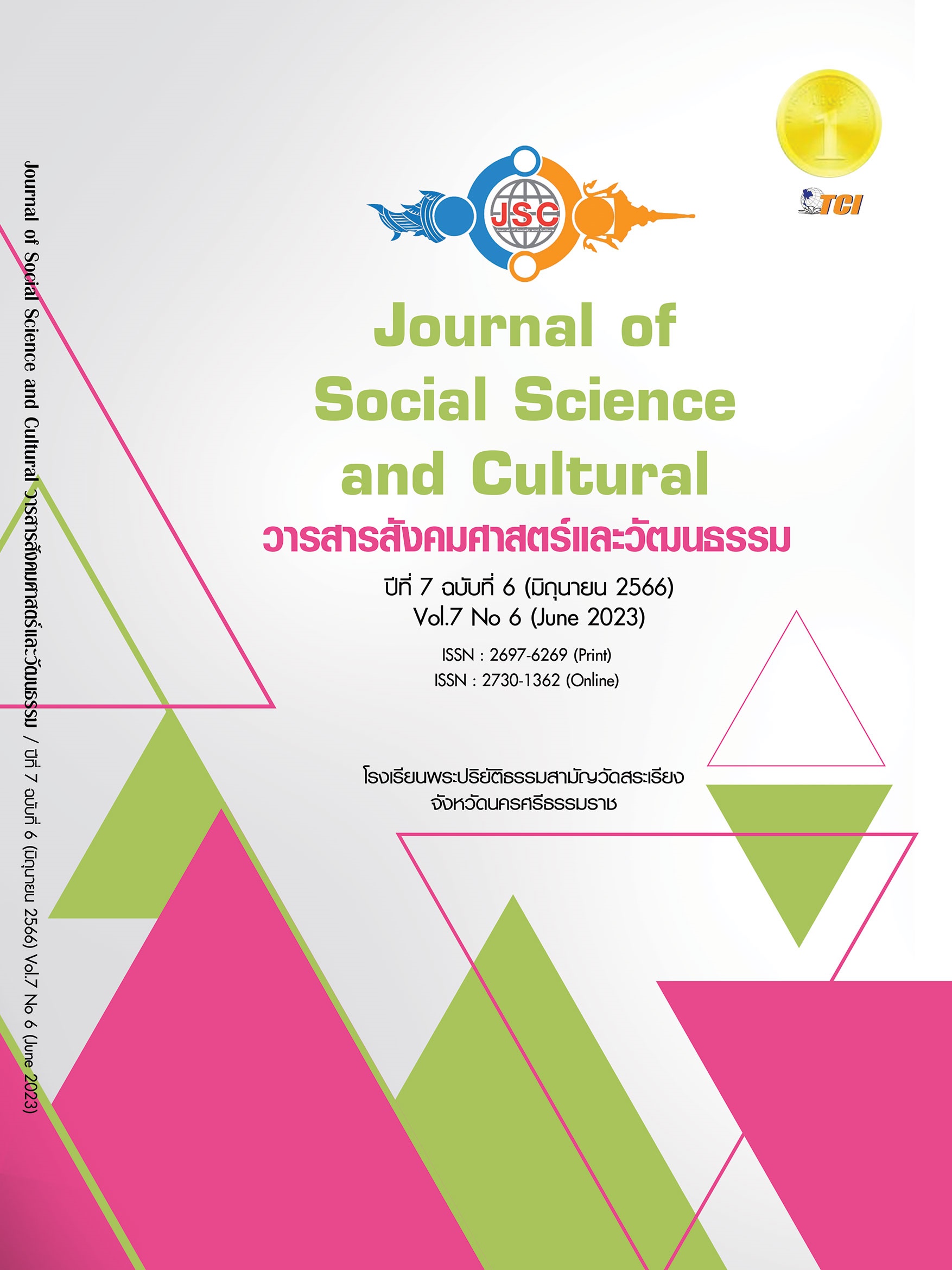CONFIRMATORY FACTOR ANALYSIS OF SOCIAL RESPONSIBILITY OF INDUSTRIAL PLANTS FOR THE PEOPLE IN THE EASTERN ECONOMIC CORRIDOR
Main Article Content
Abstract
Corporate social responsibility truly enhances the operations of industrial factories for sustainable development goals. The purposes of this research were 1) to develop the indicators in each aspect, and 2) to verify the consistency with empirical data of confirmatory factor analysis model on corporate social responsibility of industrial factories for sustainable development goals in the Eastern Economic Corridor (EEC). It was quantitative research. The research instrument used to collect data was a questionnaire. The sample group was 500 subjects living in Rayong Province. Cluster sampling and accidental sampling were implemented to select the participants. The statistics used to analyze the data were percentage, mean, standard deviation, and confirmatory factor analysis. The findings revealed that the corporate social responsibility of industrial factories for sustainable development goals in the Eastern Economic Corridor (EEC) consisted of 3 factors and 7 indicators: the first factor was public care and the indicator with the highest loading was health public compensation, the second factor was environmental care and the indicator with the highest loading was providing channels for receiving public complaints and suggestions of pollution , the third factor was participation in community development and the indicator with the highest loading was constant support of community activities. The results of structural equation model analysis revealed that the model was proved by congruence evaluation criteria including Chi-square minimum discrepancy divided by degree of freedom (CMIN/DF), comparative fix index (CFI), standardized root mean residual (SRMR), and root mean square error of approximation (RMSEA). And all the standard factor loading, composite reliability (CR), and average variance extracted (AVE) were also proved by congruence evaluation criteria.
Article Details
References
กรมควบคุมมลพิษ. (2565). สถิติการร้องเรียนปัญหามลพิษ ปี พ.ศ. 2560-2565. เรียกใช้เมื่อ 15 มีนาคม 2565 จาก https://www.pcd.go.th/stattype/1
จารุวรรณ เหมยากร. (2565). เขตปลอดอากรกิจการพาณิชย์อิเลคทรอนิกส์ภายในเขตส่งเสริมเศรษฐกิจพิเศษในพื้นที่เขตพัฒนาพิเศษภาคตะวันออก. เรียกใช้เมื่อ 22 กันยายน 2565 จาก https://www.customs.go.th/data _files/527272e1169b6cad538f91fa53e8d96f.pdf
ธานินทร์ ศิลป์จารุ. (2563). การวิจัยและวิเคราะห์ข้อมูลทางสถิติด้วย SPSS และ AMOS. (พิมพ์ครั้งที่ 18). กรุงเทพมหานคร: ห้างหุ้นส่วนสามัญบิสซิเนสอาร์แอนด์ดี.
พิพัฒน์ ยอดพฤติการ. (2562). CSR ระหว่างได้ภาพ กับได้ผล. เรียกใช้เมื่อ 26 พฤษภาคม 2562 จาก https://www.bangkokbiznews.com/blog/detail/647335
มูลนิธินิติธรรมสิ่งแวดล้อม. (2565). เครือข่ายประชาชนคนรักระยองร้อง กก.วล. – 13 ปี เขตควบคุมมลพิษระยองไม่คืบหน้า ให้เร่งรัดแก้ปัญหา. เรียกใช้เมื่อ 20 กุมภาพันธ์ 2565 จาก https://enlawfoundation.org/ rayongpollutioncontrol/
ศิริโชค ประทุมพิทักษ์. (2561). ผลกระทบต่อชุมชนที่เกิดจากการตั้งนิคมอุตสาหกรรมมาบตาพุดในโครงการพัฒนาพื้นที่ชายฝั่งทะเลภาคตะวันออก : กรณีของเทศบาลเมืองมาบตาพุด. วารสารวิชาการมหาวิทยาลัยปทุมธานี, 10(2), 82-89.
สำนักงานคณะกรรมการนโยบายเขตพัฒนาพิเศษภาคตะวันออก. (2565). ความเป็นมาของ อีอีซี. เรียกใช้เมื่อ 2 กุมภาพันธ์ 2565 จาก https://www.eeco.or.th/th/government-initiative/why-eec
สำนักงานคณะกรรมการนโยบายเขตพัฒนาพิเศษภาคตะวันออก. (2565). ภาพรวมการขอรับการส่งเสริมการลงทุนใน EEC. เรียกใช้เมื่อ 2 กุมภาพันธ์ 2565 จาก https://www.eeco.or.th/th/news/381
สำนักงานสภาพัฒนาการเศรษฐกิจและสังคมแห่งชาติ. (2562). รายงานการศึกษาผลกระทบจากการเปลี่ยนแปลงโครงสร้างประชากรและข้อเสนอแนะเชิงนโยบายต่อการพัฒนาประเทศจากผลการคาดประมาณประชากรของประเทศไทย. (พิมพ์ครั้งที่ 1). กรุงเทพมหานคร: สำนักงานสภาพัฒนาการเศรษฐกิจและสังคมแห่งชาติ.
โสภณ พรโชคชัย. (2553). แนวทางการแก้ปัญหามลพิษมาบตาพุด. จดหมายถึงรัฐบาลที่ TAF 11/235/53. เรียกใช้เมื่อ 8 สิงหาคม 2565 จาก http://www.thaiappraisal.org/thai/letter/letter_view.php?strquery =letter18.htm
Choopun, J. et al. (2021). Attitudes of Khanom Community towards CSR Activities of Khanom Gas Separation Plant, PTT Public Company Limited Year 2021. RMUTK Journal of Liberal Arts, 3(2), 89-104.
Chuarkham, K, et al. (2022). Conditions for sustainable coexistence of industrial plants and communities Case Study: Sri Trang Agro-Industry Company and Bangrak-Saphanchang Community, Mueangtrang District, Trang Province. Journal of MCU Peace Studies, 10(3), 998-1012.
Chutha, R., & Noppadon, P. (2022). Environmental Community Reponsibility Strategy Of Cement Industry In Saraburi Province. Journal of Social Science and Buddhistic Anthropology, 7(4), 243-258.
Comrey, A. L., & Lee, H. B. (1992). A First Course in Factor Analysis (2nd ed.). Hillsdale, NJ: Lawrence Erlbaum.
Cronbach, L. J. (1951). Coefficient alpha and the internal structure of tests. psychometrika, 16(3), 297-334.
Fornell, C. & Larcker, D. (1981). “Evaluating structural equation models with unobservable variables and measurementerror”. Journal of Marketing Research, 18(1), 39-50.
Freeman, R. E., et al. (2010). Stakeholder theory: The state of the art. The academy of management annals, 4(1), 403-445.
Gaskin, J. & Lim, J. (2016). "Model Fit Measures". Retrieved Febuary 11, 2023, from http://statwiki. gaskination.com/index.php?title=CFA
Hair, JR, J.F. et al. . (2011). “PLS-SEM: Indeed a Silver Bullet”. Journal of Marketing Theory andPractice, 19(2), 139-151.
Hong, J. et al. (2021). Towards environmental sustainability in the local community: Future insights for managing the hazardous pollutants at construction sites. Journal of Hazardous Materials, 403(2021), 123804.
Jenkanob, T., Loatong, P. (2021). Corporate Social Responsibility towards Entrepreneurial Ethics. Journal of Management Science Research, Surindra Rajabhat University, (5)1, 82-93.
Kaopattanaskul, P. (2020). Guideline for Management of Health and Occupational Health for Labor in Industrial Business. Journal of Safety and Health, 13(1), 10-24.
Khiewgasem, N. & Chompunth, C. (2018). EnvironmentaGovernance for Petrochemical Industry: A case study of IRPC Public Company Limited. In Proceeding National & International Conference, 1(9), 579-589.
Khotwanta, T. (2022). CSR ยุคใหม่ควรไปไกลกว่าการปลูกป่า เก็บขยะ และบริจาคของ. Retrieved สิงหาคม 2, 2565, from https://thematter.co/social/corporate-social-responsibility-trend-2022/181982
Klinkhajon, S. (2021). The Role of Environmental Practices and Competitive Advantage Effect on Organization Performance of Industrial in Thailand. Journal of Modern Management Science, 14(2), 20-34.
Kotler, P., & Lee, N. (2008). Corporate social responsibility: Doing the most good for your company and your cause. Hoboken, New Jersey: John Wiley & Sons, Inc.
Likert, R. (1932). A Technique for the Measurement of Attitudes. Archives of Psychology, 22(140), 1–55.
McWilliams, A. (2015). Corporate Social Responsibility. In (C. Cooper, L., McGee, J., Bonnici, T. S. (eds). Wiley Encyclopedia of Management: Strategic Management Volume 12. New Jersey: Wiley Encyclopedia of Management.
Noigraiprai, K., & Rodjun, J. (2021). The concept of establishing a fund to remedy damages to people's health and lives from industrial pollution by means of specific tax collection. Journal of MCU Nakhondhat, 8 (5), 363-377.
Prachayanee, J., & Pherm, L. (2021). Legal Measures In Environmental Litigation: Study The Case Of Natural Resource And Environment Valuation. Pa~n~na Panithan Journal, 6(2), 211-224.
Prapaporn, R. (2021). Legal Measures for Remedy for People Affected by DustPollution. Law and Local Society Journal, 5(1), 141-176.
Rovinelli, R. J. (1976). Methods for Validating Criterion-Referenced Test Items.Unplblisded Doctoral Dissertation. University of Massachusetts Amherst. Retrieved September 5, 2022, from https://scholarworks.umass.edu/cgi/viewcontent.cgi?referer=https://www.google.Co.th/&httpsredir=1&article=4661
&context=dissertations_1 “
Taesillapasathit, A., & Piphatanangkun, C. (2022). Management Model for Social Responsibility of Limestone Industrial Mining for Construction in Thailand in the Next Decade (2020-2029). Dhammathas Academic Journal, 22(2), 327-336.
Thumneab, K. (2021). Investigate The People’s Perspectives on The Assessment of Civil Damages Based on The Principle of Exemplary Damages About the Pollution Problem from The Municipal Sold Waste: A Case Study of Tadthong Subdistrict Administrative Organization, Sri That Dist. Udon Thani Rajabhat Uhiversity journal
of Humanties and Social Science, 10(2), 77-92.


